Terra Australis
Terra Australis (Latin for South Land) was a hypothetical continent first posited in antiquity and which appeared on maps between the 15th and 18th centuries. The existence of Terra Australis was not based on any survey or direct observation, but rather on the idea that continental land in the Northern Hemisphere should be balanced by land in the Southern Hemisphere.[1] This theory of balancing land has been documented as early as the 5th century on maps by Macrobius, who uses the term Australis on his maps.[2]
| Terra Australis | |
|---|---|
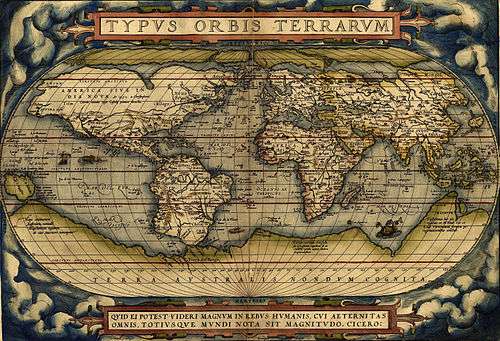 1570 map by Abraham Ortelius depicting "Terra Australis Nondum Cognita" as a large continent on the bottom of the map and also an Arctic continent | |
| Information | |
| Type | Hypothetical continent |
| Notable locations | Patalis |
Other names
Other names for the hypothetical continent have included Terra Australis Ignota, Terra Australis Incognita ("the unknown land of the south") or Terra Australis Nondum Cognita ("the southern land not yet known"). Other names were Brasiliae Australis ("the southern Brazil"),[3] and Magellanica ("the land of Magellan").[4] Matthias Ringmann called it the Ora antarctica (antarctic land) in 1505,[5] and Franciscus Monachus called it the Australis orę (Austral country).[6] In Medieval times it was known as the Antipodes.
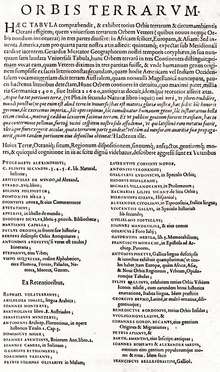
Change of name
During the eighteenth century, today's Australia was not conflated with Terra Australis, as it sometimes was in the twentieth century. Captain Cook and his contemporaries knew that the fifth continent (today's Australia), which they called New Holland, was entirely separate from the imagined (but still undiscovered) sixth continent (today's Antarctica).
In the nineteenth century, the colonial authorities in Sydney re-allocated the name Australia to New Holland and its centuries-old Dutch name eventually disappeared. Meanwhile, having lost its name of Australia, the south polar continent was nameless for decades until Antarctica was coined in the 1890s. [7]
In the early 1800s, British explorer Matthew Flinders popularized the naming of Australia after Terra Australis, giving his rationale that there was "no probability" of finding any significant land mass anywhere more south than Australia.[8] The continent that would come to be named Antarctica would be explored decades after Flinders' 1814 book on Australia, which he had titled A Voyage to Terra Australis, and after his naming switch had gained popularity.
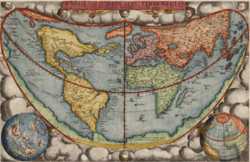
Origins of Terra Australis
Ptolemy (2nd century AD), believed that the Indian Ocean was enclosed on the south by land, and that the lands of the Northern Hemisphere should be balanced by land in the south.[1] Marcus Tullius Cicero used the term cingulus australis ("southern zone") in referring to the Antipodes in Somnium Scipionis ("Dream of Scipio").[9] The land (terra in Latin) in this zone was the Terra Australis.[10]
Legends of Terra Australis Incognita—an "unknown land of the South"—date back to Roman times and before, and were commonplace in medieval geography, although not based on any documented knowledge of the continent. Ptolemy's maps, which became well known in Europe during the Renaissance, did not actually depict such a continent, but they did show an Africa which had no southern oceanic boundary (and which therefore might extend all the way to the South Pole), and also raised the possibility that the Indian Ocean was entirely enclosed by land. Christian thinkers did not discount the idea that there might be land beyond the southern seas, but the issue of whether it could be inhabited was controversial.
The first depiction of Terra Australis on a globe was probably on Johannes Schöner's lost 1523 globe on which Oronce Fine is thought to have based his 1531 double cordiform (heart-shaped) map of the world.[11][12] On this landmass he wrote "recently discovered but not yet completely explored".[13] The body of water beyond the tip of South America is called the "Mare Magellanicum," one of the first uses of navigator Ferdinand Magellan's name in such a context.[14]
Schöner called the continent Brasiliae Australis in his 1533 tract, Opusculum geographicum. In it, he explained:
Brasilia Australis is an immense region toward Antarcticum, newly discovered but not yet fully surveyed, which extends as far as Melacha and somewhat beyond. The inhabitants of this region lead good, honest lives and are not Anthropophagi [cannibals] like other barbarian nations; they have no letters, nor do they have kings, but they venerate their elders and offer them obedience; they give the name Thomas to their children [after St Thomas the Apostle]; close to this region lies the great island of Zanzibar at 102.00 degrees and 27.30 degrees South.[15]
Mapping the southern continent
Medieval Period
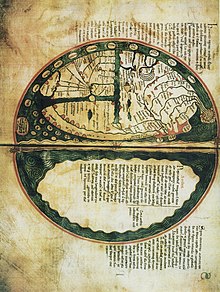
During medieval times Terra Australis was known by a different name, that being the Antipodes. First widely introduced to medieval western Europe by Isidore of Seville in his famous book the Etymologiae, the idea gained popularity over Europe, and most scholars didn’t question its existence, instead debating if it was habitable for other humans. It would later be included on some zonal Mappa mundi and intrigue medieval scholars for centuries. [16][17][18][19][20]
16th century
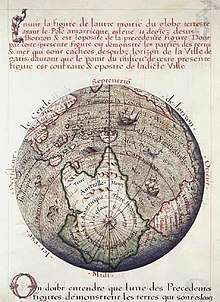
Explorers of the Age of Discovery, from the late 15th century on, proved that Africa was almost entirely surrounded by sea, and that the Indian Ocean was accessible from both west and east. These discoveries reduced the area where the continent could be found; however, many cartographers held to Aristotle's opinion. Scientists such as Gerardus Mercator (1569)[21] and Alexander Dalrymple as late as 1767[1] argued for its existence, with such arguments as that there should be a large landmass in the south as a counterweight to the known landmasses in the Northern Hemisphere. As new lands were discovered, they were often assumed to be parts of the hypothetical continent.[22]
The German cosmographer and mathematician Johannes Schöner (1477–1547) constructed a terrestrial globe in 1515, based on the world map and globe made by Martin Waldseemüller and his colleagues at St. Dié in Lorraine in 1507. Where Schöner departs most conspicuously from Waldseemüller is in his globe's depiction of an Antarctic continent, called by him Brasilie Regio. His continent is based, however tenuously, on the report of an actual voyage: that of the Portuguese merchants Nuno Manuel and Cristóvão de Haro to the River Plate, and related in the Newe Zeytung auss Presillg Landt ("New Tidings from the Land of Brazil") published in Augsburg in 1514.[23] The Zeytung described the Portuguese voyagers passing through a strait between the southernmost point of America, or Brazil, and a land to the south west, referred to as vndtere Presill (or Brasilia inferior).
This supposed "strait" was in fact the Rio de la Plata (or the San Matias Gulf). By "vndtere Presill", the Zeytung meant that part of Brazil in the lower latitudes, but Schöner mistook it to mean the land on the southern side of the "strait", in higher latitudes, and so gave to it the opposite meaning. On this slender foundation he constructed his circum-Antarctic continent to which, for the reasons that he does not explain, he gave an annular, or ring shape. In an accompanying explanatory treatise, Luculentissima quaedam terrae totius descriptio ("A Most Lucid Description of All Lands"), he explained: "The Portuguese, thus, sailed around this region, the Brasilie Regio, and discovered the passage very similar to that of our Europe (where we reside) and situated laterally between east and west.
From one side the land on the other is visible; and the cape of this region about 60 miles away, much as if one were sailing eastward through the Straits of Gibraltar or Seville and Barbary or Morocco in Africa, as our Globe shows toward the Antarctic Pole. Further, the distance is only moderate from this Region of Brazil to Malacca, where St. Thomas was crowned with martyrdom."[24]
On this scrap of information, united with the concept of the Antipodes inherited from Graeco-Roman antiquity, Schöner constructed his representation of the southern continent. His strait served as inspiration for Ferdinand Magellan's expedition to reach the Moluccas by a westward route.[25]
He took Magellan's discovery of Tierra del Fuego in 1520 as further confirmation of its existence, and on his globes of 1523 and 1533 he described it as terra australis recenter inventa sed nondum plene cognita ("Terra Australis, recently discovered but not yet fully known"). It was taken up by his followers, the French cosmographer Oronce Fine in his world map of 1531, and the Flemish cartographers Gerardus Mercator in 1538 and Abraham Ortelius in 1570. Schöner's concepts influenced the Dieppe school of mapmakers, notably in their representation of Jave la Grande.[26]
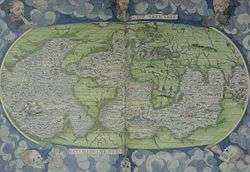
Terra Australis was depicted on the mid-16th-century Dieppe maps, where its coastline appeared just south of the islands of the East Indies; it was often elaborately charted, with a wealth of fictitious detail. There was much interest in Terra Australis among Norman and Breton merchants at that time. In 1566 and 1570, Francisque and André d'Albaigne presented Gaspard de Coligny, Admiral of France, with projects for establishing relations with the Austral lands. Although the Admiral gave favourable consideration to these initiatives, they came to nought when Coligny was killed in 1572.[27]
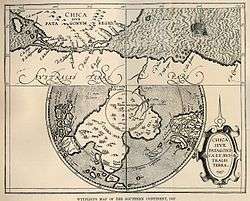
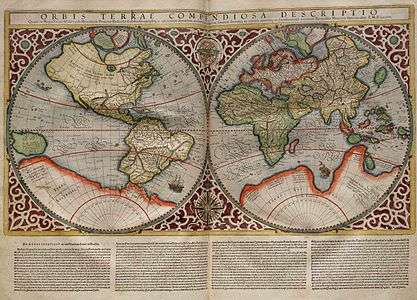
Gerardus Mercator believed in the existence of a large Southern continent on the basis of cosmographic reasoning, set out in the abstract of his Atlas or Cosmographic Studies in Five Books, as related by his biographer, Walter Ghim, who said that even though Mercator was not ignorant that the Austral continent still lay hidden and unknown, he believed it could be "demonstrated and proved by solid reasons and arguments to yield in its geometric proportions, size and weight, and importance to neither of the other two, nor possibly to be lesser or smaller, otherwise the constitution of the world could not hold together at its centre".[28]
The Flemish geographer and cartographer, Cornelius Wytfliet, wrote concerning the Terra Australis in his 1597 book, Descriptionis Ptolemaicae Augmentum:
The terra Australis is therefore the southernmost of all other lands, directly beneath the antarctic circle; extending beyond the tropic of Capricorn to the West, it ends almost at the equator itself, and separated by a narrow strait lies on the East opposite to New Guinea, only known so far by a few shores because after one voyage and another that route has been given up and unless sailors are forced and driven by stress of winds it is seldom visited. The terra Australis begins at two or three degrees below the equator and it is said by some to be of such magnitude that if at any time it is fully discovered they think it will be the fifth part of the world. Adjoining Guinea on the right are the numerous and vast Solomon Islands which lately became famous by the voyage of Alvarus Mendanius.[29]
Juan Fernandez, sailing from Chile in 1576, claimed he had discovered the Southern Continent.[30] The Polus Antarcticus map of 1641 by Henricus Hondius, bears the inscription: "Insulas esse a Nova Guinea usque ad Fretum Magellanicum affirmat Hernandus Galego, qui ad eas explorandas missus fuit a Rege Hispaniae Anno 1576 (Hernando Gallego, who in the year 1576 was sent by the King of Spain to explore them, affirms that there are islands from New Guinea up to the Strait of Magellan)".[31]
17th century
Luís Vaz de Torres, a Galician or Portuguese navigator who commanded the San Pedro y San Pablo, the San Pedrico and the tender or yacht, Los Tres Reyes Magos during the 1605–1606 expedition led by Pedro Fernandes de Queiros in quest of the Southern Continent, proved the existence of a passage south of New Guinea, now known as Torres Strait. Commenting on this in 1622, the Dutch cartographer and publisher of Queiros' eighth memorial, Hessel Gerritsz, noted on his Map of the Pacific Ocean: "Those who sailed with the yacht of Pedro Fernando de Quiros in the neighbourhood of New Guinea to 10 degrees westward through many islands and shoals and over 23 and 24 fathoms for as many as 40 days, estimated that Nova Guinea does not extend beyond 10 degrees to the south; if this be so, then the land from 9 to 14 degrees would be a separate land".[32]
Pedro Fernandes de Queirós, another Portuguese navigator sailing for the Spanish Crown, saw a large island south of New Guinea in 1606, which he named La Austrialia del Espiritu Santo.[33] He represented this to the King of Spain as the Terra Australis incognita. In his 10th Memorial (1610), Queirós said: "New Guinea is the top end of the Austral Land of which I treat [discuss], and that people, and customs, with all the rest referred to, resemble them".[34]
Dutch father and son Isaac and Jacob Le Maire established the Australische Compagnie (Australian Company) in 1615 to trade with Terra Australis, which they called "Australia".[35]
The Dutch expedition to Valdivia of 1643 intended to round Cape Horn sailing through Le Maire Strait but strong winds made it instead drift south and east.[36] The small fleet led by Hendrik Brouwer managed to enter the Pacific ocean sailing south of the island disproving earlier beliefs that it was part of Terra Australis.[36][37][38]
The cartographic depictions of the southern continent in the 16th and early 17th centuries, as might be expected for a concept based on such abundant conjecture and minimal data, varied wildly from map to map; in general, the continent shrank as potential locations were reinterpreted. At its largest, the continent included Tierra del Fuego, separated from South America by a small strait; New Guinea; and what would come to be called Australia. In Ortelius's atlas Theatrum Orbis Terrarum, published in 1570, Terra Australis extends north of the Tropic of Capricorn in the Pacific Ocean.
As long as it appeared on maps at all, the continent minimally included the unexplored lands around the South Pole, but generally much larger than the real Antarctica, spreading far north – especially in the Pacific Ocean. New Zealand, first seen by the Dutch explorer Abel Tasman in 1642, was regarded by some as a part of the continent.
18th century
Alexander Dalrymple, the Examiner of Sea Journals for the English East India Company,[39] whilst translating some Spanish documents captured in the Philippines in 1762, found de Torres's testimony. This discovery led Dalrymple to publish the Historical Collection of the Several Voyages and Discoveries in the South Pacific Ocean in 1770–1771. Dalrymple presented a beguiling tableau of the Terra Australis, or Southern Continent:
The number of inhabitants in the Southern Continent is probably more than 50 millions, considering the extent, from the eastern part discovered by Juan Fernandez, to the western coast seen by Tasman, is about 100 deg. of longitude, which in the latitude of 40 deg. amounts to 4596 geographic, or 5323 stature miles. This is a greater extent than the whole civilized part of Asia, from Turkey to the eastern extremity of China. There is at present no trade from Europe thither, though the scraps from this table would be sufficient to maintain the power, dominion, and sovereignty of Britain, by employing all its manufacturers and ships. Whoever considers the Peruvian empire, where arts and industry flourished under one of the wisest systems of government, which was founded by a stranger, must have very sanguine expectations of the southern continent, from whence it is more than probable Mango Capac, the first Inca, was derived, and must be convinced that the country, from whence Mango Capac introduced the comforts of civilized life, cannot fail of amply rewarding the fortunate people who shall bestow letters instead of quippos (quipus), and iron in place of more awkward substitutes.[40]
Dalrymple's claim of the existence of an unknown continent aroused widespread interest and prompted the British government in 1769 to order James Cook in HM Bark Endeavour to seek out the Southern Continent to the South and West of Tahiti, discovered in June 1767 by Samuel Wallis in HMS Dolphin and named by him King George Island.[41] The London press reported in June 1768 that two ships would be sent to the newly discovered island and from there to "attempt the Discovery of the Southern Continent".[42] A subsequent press report stated: "We are informed, that the Island which Captain Wallis has discovered in the South-Sea, and named George's Land, is about fifteen hundred Leagues to the Westward and to Leeward of the Coast of Peru, and about five-and-thirty Leagues in circumference; that its principal and almost sole national Advantage is, its Situation for exploring the Terra Incognita of the Southern Hemisphere. The Endeavour, a North-Country Cat, is purchased by the Government, and commanded by a Lieutenant of the Navy; she is fitting out at Deptford for the South-Sea, thought to be intended for the newly-discovered Island".[43] The aims of the expedition were revealed in days following: "To-morrow morning Mr. Banks, Dr. Solano [sic], with Mr. Green, the Astronomer, will set out for Deal, to embark on board the Endeavour, Capt. Cook, for the South Seas, under the direction of the Royal Society, to observe the Transit of Venus next summer, and to make discoveries to the South and West of Cape Horn".[44] The London Gazetteer was more explicit when it reported on 18 August 1768: "The gentlemen, who are to sail in a few days for George's Land, the new discovered island in the Pacific ocean, with an intention to observe the Transit of Venus, are likewise, we are credibly informed, to attempt some new discoveries in that vast unknown tract, above the latitude 40".[45] The results of this first voyage of James Cook in respect of the quest for the Southern Continent were summed up by Cook himself. He wrote in his Journal on 31 March 1770 that the Endeavour's voyage "must be allowed to have set aside the most, if not all, the Arguments and proofs that have been advanced by different Authors to prove that there must be a Southern Continent; I mean to the Northward of 40 degrees South, for what may lie to the Southward of that Latitude I know not".[46]
The second voyage of James Cook aboard HMS Resolution explored the South Pacific for the landmass between 1772 and 1775 whilst also testing the Larcum Kendall's K1 chronometer as a method for measuring longitude.[47]
Decline of the idea
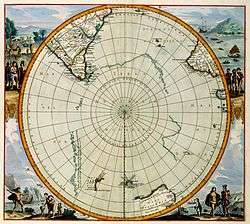
Over the centuries the idea of Terra Australis gradually lost its hold. In 1616, Jacob Le Maire and Willem Schouten's rounding of Cape Horn proved that Tierra del Fuego was a relatively small island, while in 1642 Abel Tasman's first Pacific voyage proved that Australia was not part of the mythical southern continent. Much later, James Cook sailed around most of New Zealand in 1770, showing that even it could not be part of a large continent. On his second voyage he circumnavigated the globe at a very high southern latitude, at some places even crossing the Antarctic Circle, showing that any possible southern continent must lie well within the cold polar areas.[47] There could be no extension into regions with a temperate climate, as had been thought before. In 1814, Matthew Flinders published the book A Voyage to Terra Australis. Flinders had concluded that the Terra Australis as hypothesized by Aristotle and Ptolemy did not exist, so he wanted the name applied to what he saw as the next best thing: "Australia". He wrote:
There is no probability, that any other detached body of land, of nearly equal extent, will ever be found in a more southern latitude; the name Terra Australis will, therefore, remain descriptive of the geographical importance of this country, and of its situation on the globe: it has antiquity to recommend it; and, having no reference to either of the two claiming nations, appears to be less objectionable than any other which could have been selected.
...with the accompanying note at the bottom of the page:
Had I permitted myself any innovation upon the original term, it would have been to convert it into AUSTRALIA; as being more agreeable to the ear, and an assimilation to the names of the other great portions of the earth.[8]
His conclusion would soon be revealed as a mistake, but by that time the name had stuck.[48]
The Province of Beach
A land feature known as the "Province of Beach" or "Boeach" – from the Latin Provincia boëach – appears to have resulted from mistranscriptions of a name in Marco Polo's Il Milione (Book III). Polo described his journey by sea from China to India by way of Champa (provincia ciamba; modern southern Vietnam), Java Major), Locach (modern Lop Buri),[49] and Sumatra (Java Minor). In Cantonese, Lavo (an early name of Lop Buri) was pronounced "Lo-huk" 羅斛 and Locach was Marco Polo's transcription of this name.[50] According to Polo, Locach was a kingdom where gold was "so plentiful that no one who did not see it could believe it". Polo's narrative describes the route southward from Champa toward Sumatra, but by a slip of the pen the name "Java" (which Polo did not himself visit) was substituted for "Champa" as the point of departure,[51] thereby mis-locating Sumatra and Lochach south of Java (rather than Champa). Consequently, some geographers believed that Sumatra and Lochcach were near, or extensions of, Terra Australis.[52]
In the German cursive script, Locach and Boeach look similar. A feature known as the "Province of Beach" or "Boeach" – from the Latin Provincia boëach – appears on European maps as early as the 15th century. On a map of the world published in Florence in 1489 by Henricus Martellus, the Latin name provincia boëach is given to a southern neighbour of Champa. In fact, by 1532, in an edition of Marco Polo's Travels, Locach was changed to Boëach, later shortened to Beach.[53]
By the mid-16th century, according to Henry Yule, the editor of a modern (1921) edition of Polo's Travels, some geographers and cartographers followed the error in older editions of Polo that "placed ... the land of "Boeach" (or Locac)" south-east of Java and "introduced in their maps a continent in that situation".[54] Gerard Mercator did just that on his 1541 globe, placing Beach provincia aurifera ("Beach the gold-bearing province") in the northernmost part of the Terra Australis in accordance with the faulty text of Marco Polo's Travels. The landmass of Beach remained in this location on Mercator's world map of 1569, with the amplified description, quoting Marco Polo, Beach provincia aurifera quam pauci ex alienis regionibus adeunt propter gentis inhumanitatem ("Beach the gold-bearing province, wither few go from other countries because of the inhumanity of its people") with Lucach regnum shown somewhat to its south west.[55] Following Mercator, Abraham Ortelius also showed BEACH and LVCACH in these locations on his world map of 1571.
In 1596, on a popular map by Jan Huygen van Linschoten, showed BEACH and LOCACH, projecting from the map's southern edge as the northernmost parts of the Terra Australis long hypothesized by Europeans. Ironically, an accidental encounter by the Dutch vessel Eendracht, commanded by Dirk Hartog, with Shark Bay, Western Australia in 1616, appeared to confirm that land existed where the maps showed Beach; Hartog named the wider landmass Eendrachtsland, after his ship. Nevertheless, the old name persisted for some time: in August 1642, the Council of the Dutch East India Company – evidently still relying on Linschoten's map – despatched Abel Tasman and Franchoijs Jacobszoon Visscher on a voyage of exploration to areas, including Beach and its purported gold, between the Cape of Good Hope and Staten Land (near Cape Horn) and south of the Solomon Islands.[56] which one of the objects was to obtain knowledge of "all the totally unknown provinces of Beach".[57]
Antarctica
Antarctica was finally sighted in the hypothetical area of Terra Australis in 1820. The extent of Terra Australis was finally determined, also proving the Southern Hemisphere has much less land than the Northern.
In fiction
The unexplored southern continent was a frequent subject of fantastic fiction in the 17th and 18th centuries in the imaginary voyages genre. Among the works which dealt with imaginary visits to the continent (which at the time was still believed to be real) were:
- Mundus alter et idem, sive Terra Australis antehac semper incognita lustrata (1605), a satirical Latin work by Joseph Hall, Bishop of Norwich.
- The Isle of Pines, or, A late discovery of a fourth island near Terra Australis incognita, by Henry Cornelius van Sloetten (1668) by Henry Neville.
- La terre australe connue (1676) by Gabriel de Foigny.
- Histoire des Sevarambes (1675–1679) by Denis Vairasse d'Allais.
- Voyages et avantures de Jaques Massé (c. 1715, falsely dated 1710) by Tyssot de Patot.
- Miscellanea aurea: The Fortunate Shipwreck, or a description of New Athens in Terra Australis incognita (1720) by Thomas Killigrew.
- Relation d'un voyage du Pole Arctique, au Pole Antarctique par le centre du monde (1721), anonymous.
- Relation du royaume des Féliciens (1727) by the Marquis de Lassay.
- Viaggi di Enrico Wanton alle Terre incognite Australi (1749) by Zaccaria Seriman.
- Voyage de Robertson, aux Terres Australes, traduit sur le manuscrit anglois (1767), anonymous.
- La découverte australe par un homme-volant (1781) by Restif de la Bretonne.
- The idea of Terra Australis was also used by Terry Pratchett in his Discworld series of novels (1983–2014) where the World is balanced by the strange and little-known Counterweight Continent.
See also
Further reading
- Collingridge, George. "The Discovery of Australia". Project Gutenberg Australia. eBook No.: 0605401h.html published August 2006; originally published Sydney, 1895.
References
- John Noble Wilford: The Mapmakers, the Story of the Great Pioneers in Cartography from Antiquity to Space Age, p. 139, Vintage Books, Random House 1982, ISBN 0-394-75303-8
- Ambrosius Aurelius Theodosius Macrobius, Zonenkarte. Retrieved 7 July 2014.
- Johannes Schoener, Opusculum Geographicum, Norimberga, [1533], f.21v
- ORBIS TERRARUM; explanatory text on the reverse of Ortelius' world map Tabula Orbis Terrarum (1570).
- Matthias Ringmann, De Ora antarctica per regem Portugallie pridem inventa [The antarctic country discovered some time since by the King of Portugal], Strassburg, 1505.
- "Orę", i.e., "orae"; Robert J. King, “Franciscus Monachus and the Antipodes”, Map Matters, Issue 38, Spring 2019, pp.27-32.
- Cameron-Ash, M. (2018). Lying for the Admiralty: Captain Cook's Endeavour Voyage. Sydney: Rosenberg. p. 19–20. ISBN 9780648043966.
- Matthew Flinders, A voyage to Terra Australis (Introduction). The State Library of South Australia. Retrieved 13 June 2019.
- Duo [cingulis] sunt habitabiles, quorum australis ille, in quo qui insistunt adversa vobis urgent vestigia, nihil ad vestrum genus ("Two of them [the five belts or zones that gird and surround the earth] are habitable, of which the southern, whose inhabitants are your antipodes, bears no relation to your people"). Alfred Hiatt, "Terra Australis and the Idea of the Antipodes", Anne M. Scott (ed), European Perceptions of Terra Australis, Ashgate Publishing, 2012, pp. 18–10.
- Eisler, William (1995). The Furthest Shore: Images of Terra Australis from the Middle Ages to Captain Cook. Cambridge University Press. p. 10. ISBN 0-521-39268-3.
- Albert-Marie-Ferdinand Anthiaume, "Un pilote et cartographe havrais au XVIe siècle: Guillaume Le Testu", Bulletin de Géographie Historique et Descriptive, Paris, Nos 1–2, 1911, pp. 135–202, n.b. p. 176.
- Franz von Wieser, Magalhães-Strasse und Austral-Continent. Auf den Globen Johannes Schöner. Beitrage zur Geschichte der Erdkunde im xvi. Jahrhundert, Innsbruck, 1881 (reprinted Amsterdam, Meridian, 1967)
- Pelletier, Monique (1995). "The cordiform World maps by Oronce Fine". Cartographica Helvetica. 12: 27–37. Retrieved 31 December 2011.
- Orontius Fineus: Rare Book and Special Collections Division, Library of Congress, 1531, (147.03.00)
- Johannes Schoener, Opusculum Geographicum, Norimberga, [1533], Pt.II, cap.xx. Ioannis Schoneri ... Opusculum geographicum
- Medieval, Daily (22 June 2012). "Daily Medieval: The Antipodes". Daily Medieval. Retrieved 12 July 2020.
- Haase, Wolfgang; Reinhold, Meyer (1994). The Classical Tradition and the Americas: European images of the Americas and the classical tradition (2 pts.). Walter de Gruyter. ISBN 978-3-11-011572-7.
- "CATHOLIC ENCYCLOPEDIA: Antipodes". www.newadvent.org. Retrieved 12 July 2020.
- Sparavigna, Amelia (14 November 2012). "From Rome to the Antipodes: The Medieval Form of the World" (PDF).
- "The Medieval Antipodes | History Today". www.historytoday.com. Retrieved 12 July 2020.
- Zuber, Mike A. (2011). "The Armchair Discovery of the Unknown Southern Continent: Gerardus Mercator, Philosophical Pretensions and a Competitive Trade". Early Science and Medicine. 16 (6): 505–541. doi:10.1163/157338211X607772.
- Carlos Pedro Vairo, TERRA AUSTRALIS Historical Charts of Patagonia, Tierra del Fuego and Antarctica. Ed. Zagier & Urruty Publicationa, 2010.
- Newen Zeytung auss Presillg Landt
- Chet van Duzer, Johann Schöner's Globe of 1515: Transcription and Study, Philadelphia, American Philosophical Society, Transactions, Volume 100, Part 5, 2010.
- Franz von Wieser, Magalhães-Strasse und Austral-Continent. Auf den Globen Johannes Schöner. Beitrage zur Geschichte der Erdkunde im xvi. Jahrhundert, Innsbruck, 1881 (reprinted Amsterdam, Meridian, 1967), p. 65.
- Armand Rainaud, Le Continent Austral: Hypotheses et Découvertes, Paris, Colin, 1893 (repr. Amsterdam, Meridian Pub. Co., 1965), p. 291.
- E.T. Hamy, "Francisque et André d'Albaigne: cosmographes lucquois au service de la France"; "Nouveau documents sur les frères d'Albaigne et sur le projet de voyage et de découvertes présenté à la cour de France"; and "Documents relatifs à un projet d'expéditions lointaines présentés à la cour de France en 1570", in Bulletin de Géographie Historique et Descriptive, Paris, 1894, pp. 405–433; 1899, pp. 101–110; and 1903, pp. 266–273.
- Walter Ghim, "Vita…Gerardi Mercatoris Rupelmundani", Gerardi Mercatoris Atlas sive Cosmographice Meditationes de Fabrica Mundi et Fabricate Figura, Amsterdami, 1606, p. 12.
- Australis igitur terra omnium aliarum terrarum australissima, directe subiecta antarctico circulo, Tropicum Capricorni vltra ad Occidentem excurrens, in ipfo penè aequatore finitur, tenuique difcreta freto Nouam Guineam Orienti obijcit, paucis tãtum hactenus littoribus cognitam, quòd post vnam atque alteram nauigationem, curfus ille intermissus fit, & nisi coactis impulsifquc nautis ventorum turbine, rarius eò adnauigetur. Australis terra initium sumit duobus aut tribes gradibus fub aequatore, tantaeque a quibufdam magnitudinis esse perhibetur, vt fi quando integrè deteda erit, quintam illam mundi partem fore arbitrentur. Guinea a dextris adhrent Salomoniae insulae multae & quae nauigatione Aluari Mendanij nuper inclaruêre, &c. Cornelius Wytfliet, Descriptionis Ptolemaicae Augmentum, Louvain, 1597, p. 20.
- José Toribio Medina, El Piloto Juan Fernandez, Santiago de Chile, 1918, reprinted by Gabriela Mistral, 1974, pp. 136, 246.
- An on-line image of this map is at: http://nla.gov.au/nla.map-t732.
- Hessel Gerritsz (c. 1581–1632), Map of the Pacific Ocean, 1622, Bibliothèque nationale de France, Paris, département des Cartes et Plans, SH, Arch. 30
- "The Spanish quest for Terra Australis". State Library of New South Wales. 13 November 2015. Retrieved 13 May 2018.
- Translation by Dolores Turró of Memorial No. 10
- Spieghel der Australische Navigatie; cited by A. Lodewyckx, "The Name of Australia: Its Origin and Early Use", The Victorian Historical Magazine, Vol. XIII, No. 3, June 1929, pp. 100–191.
- Barros Arana, Diego. "Capítulo XI". Historia general de Chile (in Spanish). Tomo cuarto (Digital edition based on the second edition of 2000 ed.). Alicante: Biblioteca Virtual Miguel de Cervantes. p. 280.
- Lane, Kris E. (1998). Pillaging the Empire: Piracy in the Americas 1500–1750. Armonk, N.Y.: M.E. Sharpe. p. 88. ISBN 978-0-76560-256-5.
- Kock, Robbert. "Dutch in Chile". Colonial Voyage.com. Archived from the original on 29 February 2016. Retrieved 23 October 2014.
- Howard T. Fry, Alexander Dalrymple (1737–1808) and the Expansion of British Trade, London, Cass for the Royal Commonwealth Society, 1970, pp. 229–230.
- Alexander Dalrymple, An Historical Collection of the several Voyages and Discoveries in the South Pacific Ocean, Vol.I, London, 1769 and 1770, pp. xxviii–xxix.
- Andrew Cook, Introduction to An account of the discoveries made in the South Pacifick Ocean / by Alexander Dalrymple ; first printed in 1767, reissued with a foreword by Kevin Fewster and an essay by Andrew Cook, Potts Point (NSW), Hordern House Rare Books for the Australian National Maritime Museum, 1996, pp. 38–9.
- The St. James's Chronicle, 11 June and The Public Advertiser, 13 June 1768.
- The St. James's Chronicle, 18 June, The Gazetteer, 20 June and' 'The Westminster Journal, 25 June 1768.
- Lloyd's Evening Post, 5 August, The St. James's Chronicle, 6 August, Courier du Bas-Rhin (Cleves), 1768.
- Also in Lloyd's Evening Post, 19 August and The New York Journal, 3 November 1768.
- W.J.L. Wharton, Captain Cook's Journal During the First Voyage Round the World, London, 1893. See also J. C. Beaglehole and R. A. Skelton (eds.), The Journals of Captain James Cook on His Voyages of Discovery, Vol. 1, The Voyage of the Endeavor, 1768–1771, Cambridge University Press for the Hakluyt Society, 1955, p. 290.
- Wales, William. "Log book of HMS 'Resolution'". Cambridge Digital Library. Retrieved 28 May 2013.
- Avan Judd Stallard, "Origins of the Idea of Antipodes: Errors, Assumptions, and a Bare Few Facts", Terrae Incognitae, Volume 42, Number 1, September 2010, pp. 34–51.
- Lavo (Thai ลพบร) was named after Lavo, the son of Rama in Hindu mythology). (G. E. Gerini, Researches on Ptolemy's geography of Eastern Asia (further India and Indo-Malay archipelago), London, Royal Asiatic Society, Asiatic Society Monographs vol.1, 1909, p. 180.
- Paul Pelliot, Notes on Marco Polo, Paris, Imprimerie Nationale, 1963, Vol.II, pp. 768–9, note 2.
- Milione: il Milione nelle redazioni toscana e franco–italiana, Le Divisament dou Monde, Gabriella Ponchi (ed.), Milano, Arnoldo Mondadori Editore, 1982, p. 540: cap. clxiii, "La grant isle de Java".
- James R. McClymont, "The Theory of an Antipodal Southern Continent during the Sixteenth Century", Report of the Fourth Meeting of the Australasian Association for the Advancement of Science, Hobart, January 1892, Hobart, the Association, 1893, pp. 442–462; Paul Pelliot, Notes on Marco Polo, Paris, Imprimerie Nationale, 1963, Vol.II, p. 769.
- Simon Grynaeus and Johann Huttich, Novus Orbis Regionum ac Insularum, Basel and Paris, 1532, Marco Polo cap.xi, "De provincia Boëach"; cited in Thomas Suarez, Early Mapping of Southeast Asia, Hong Kong, Periplus, 1999, p. 160.
- Sir Henry Yule (ed.), The Book of Ser Marco Polo, London, Murray, 1921, Volume 2, pp. 276–280.
- Peter van der Krogt, Globi Neerlandici: The Production of Globes in the Low Countries, Utrecht, HES Publishers, 1993, p. 64, plate 2.14.
- Andrew Sharp, The Voyages of Abel Janszoon Tasman, Oxford, Clarendon Press, 1968, p. 25.
- J.E. Heeres, "Abel Janszoon Tasman, His Life and Labours", Abel Tasman's Journal, Los Angeles, 1965, pp. 137, 141–2; cited in Andrew Sharp, The Voyages of Abel Janszoon Tasman, Oxford, Clarendon Press, 1968, p. 24.
.svg.png)
.svg.png)
.svg.png)
.svg.png)
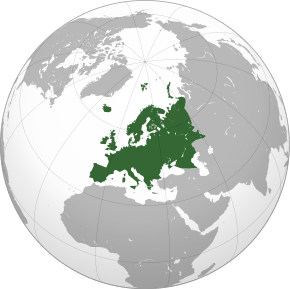
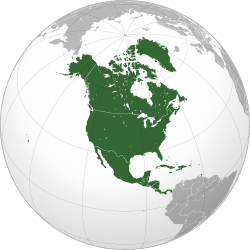
.svg.png)
_political.svg.png)
.svg.png)
.svg.png)
.svg.png)